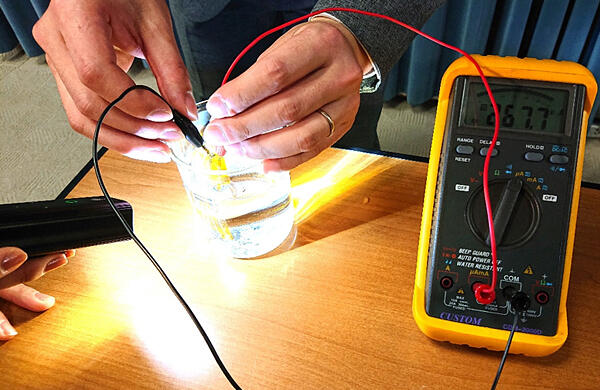Ultrathin organic solar cells that can be integrated into clothing are expected to become commonly used wearable devices; however, their susceptibility to water is a major concern. An international joint research group led by Senior Research Scientist Kenjiro Fukuda, Postdoctoral Researcher Sixing Xiong, and Team Leader Takao Someya of the Emergent Soft System Research Team at the RIKEN Center for Emergent Matter Science has, from a chance discovery, enhanced the water resistance of ultrathin organic solar cells. This has led to the successful development of devices capable of functioning underwater. Fukuda commented, "Upon placing the experimentally failed devices on a hot plate alongside other items for a day, we observed an enhancement in their water resistance performance. If we had dismissed them as useless and discarded them, we would not have made this discovery." The results have been published in Nature Communications.

The integration of wearable devices, which can generate electricity from clothing, with sensors opens up the possibility of continuous monitoring of biometric information such as blood pressure and body temperature. This innovative approach is promising for disease prevention. Organic solar cells have emerged as the primary candidate for supplying this power, boasting the capacity to deliver high power within the milliwatt range while maintaining high flexibility.
Incorporating organic solar cells into wearable applications necessitates water resistance as it is impractical to completely eliminate the risk that clothes and skin are exposed to moisture due to everyday activities like exposing to the rain, dealing with condensation, hand washing, and laundering.
The research group has been conducting research and development of new structures for organic solar cells by employing encapsulation films to enhance the water resistance of ultrathin organic solar cells.
Nevertheless, existing encapsulation film technology cannot provide complete waterproofing for ultrathin organic solar cells while retaining their flexibility. Therefore, there remains a need for fundamental improvements in the structure of organic solar cells to address this challenge. In organic solar cells, a hole-transporting layer is provided between the anode and the power-generating layer for efficiently transporting holes from the power-generating layer to the anode. The water resistance of organic solar cells is diminished since the hole-transporting layer is susceptible to water.
The research group fabricated and conducted experiments with various devices to improve the heat resistance of the hole-transporting layer. During that period, a failed sample with a diminished power-generating efficiency and a successful sample with high power-generating efficiency were produced. They were placed together on a hot plate and heated to 85 ℃ for 24 h. The power-generating efficiency of the failed sample was significantly improved.
"Initially, we thought we had considered the wrong sample, but upon obtaining the same results upon retesting, we found the phenomenon interesting. Therefore, we conducted various tests and noted a significant enhancement in its water resistance properties," stated Fukuda.
Organic solar cells incorporating a direct stacking of silver, serving as the anode, onto the power-generating layer without a hole-transporting layer exhibit notably diminished power-generating efficiency. This is attributed to the inadequate extraction of holes from the power-generating layer to the anode in the absence of a dedicated hole-transporting layer.
When this organic solar cell is heated to 85 ℃ for 24 h in air, silver oxidizes at the interface between the anode and the power-generating layer. The silver oxide between the anode and the power-generating layer acts as a hole-transporting layer and efficiently removes holes, resulting in a significant improvement in the energy-conversion efficiency of the organic solar cell.
When the fabricated ultrathin organic solar cells were exposed to simulated sunlight (output of 100 milliwatts/square centimeter), the short circuit current density (JSC) improved from 15.8 to 26.5 milliamperes/square centimeter, open circuit voltage (VOC) improved from 0.05 to 0.77 volts, and fill factor improved from 27% to 71%, while the energy-conversion efficiency improved from 0.2% to 14.3%. This is due to the oxidation of the silver comprising the anode, leading to an increase in its work function than that of normal silver.
In addition, tensile peeling tests on the anode and the power-generating layer were conducted using organic solar cells with molybdenum oxide and silver, which serve as typical hole-transporting layers, alongside the newly developed organic solar cell. The results indicated that in the molybdenum oxide solar cells, the interface adhesion strength between the molybdenum oxide and the power-generating layer was 0.7 megapascal. In contrast, the silver oxide solar cells fabricated in this study exhibited an interface adhesion strength between the silver oxide and the power-generating layer of 1.5 megapascal, surpassing that of the molybdenum oxide solar cells by more than twice. The adhesive strength of molybdenum oxide organic solar cells is weak; therefore, the molybdenum oxide and the power-generating layer are easily detached when immersed in water. In contrast, when the fabricated silver oxide organic solar cells were immersed in water, no exfoliation between the silver oxide and the power-generating layer was observed.
The fabricated ultrathin organic solar cells with a thickness of three microns retained 89% of their energy-conversion efficiency after immersion in water for 4 h and 96% of their energy-conversion efficiency after 300 stretching−releasing cycles at 30% strain underwater.

Continuous operation in water for more than 60 min was achieved. This improvement in water resistance performance is an important step toward the integration of organic thin film solar cells into wearable devices. The idea of oxidizing the silver within the hole-transporting layer is also a break from the conventional wisdom and opens up new possibilities.
Journal Information
Publication: Nature Communications
Title: Waterproof and ultraflexible organic photovoltaics with improved interface adhesion
DOI: 10.1038/s41467-024-44878-z
This article has been translated by JST with permission from The Science News Ltd. (https://sci-news.co.jp/). Unauthorized reproduction of the article and photographs is prohibited.




